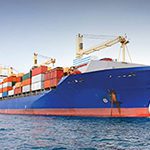
The Digital Container Shipping Association (DCSA) has released its first standards for data flows – an important first step in the process of ending the fragmentation that is holding back the development of digital technologies in the industry.
In an announcement at the beginning of September, the DCSA, which was only officially established in April this year, launched what it has called an “Industry Blueprint” that sets out current standards for the processes used in container shipping. The aim is that carriers will align to it when delivering “digitalisation and standardisation initiatives in the industry in the future”. The Blueprint includes a glossary of terms, a process catalogue and process maps for three types of journeys – shipment, equipment and vessel.
The DCSA now comprises AP Moller-Maersk, Hapag-Lloyd, MSC, ONE and CMA CGM as well as (pending regulatory approval) Evergreen Line, Hyundai Merchant Marine, Yang Ming Marine Transport Corporation and ZIM Integrated Services. This means that it now represents 70% of the market, so it has a significant voice.
A welcome move
This process is long overdue and certainly one that ORBCOMM customers will welcome. Although the digitalisation of the maritime and intermodal industries is progressing fast, as we set out in a previous blog, there are concerns at the moment that companies are not getting the right benefits for sharing their data and that too many products are siloed. André Simha global chief information officer at MSC and now chairman of the supervisory board at DCSA, has said that these siloes lead to “frustration and more bureaucracy for customers and other collaboration partners”. On a practical level, it also makes it harder to future proof these products in a fast-moving industry.
This cannot last. After the launch of the Industry Blueprint, Simha expanded his thinking in a post on LinkedIn, explaining that technology has made doing business in the B2C sphere simpler than ever, with “seamless and intuitive services”. But when those consumers turn up to work, “our systems seem outdated at best and defunct at worst”. Customers now expect complete visibility of the location and status of their shipments so that they can plan and allocate resources efficiently. They will not accept being kept in the dark because data cannot easily flow between products. It’s no good going from dark, dumb and disconnected to smart and visible if that visibility is then restricted to a select group. The way forward is clear – developing in a more open and collaborative manner will streamline processes for regulators, port authorities, shipping lines and other industry participants.
A new ecosystem
As the hardware behind IoT and telematics becomes mature, focus must now shift to the best ways to present this data to all stakeholders, combining and integrating datastreams across all platforms and enterprise software. In effect, we need a system of systems – a way of ensuring that, although no one platform dominates, there is an ecosystem that allows users to integrate multiple smart devices and suppliers. This will require a new kind of DeviceCloud middleware that can channel data from any device into any enterprise software.
Standardisation can be a long and difficult process, so the DCSA should be applauded for moving so quickly with this blueprint. They were driven by the knowledge that, as Simha has said, the container shipping industry as being “at a fairly low start of digitalisation,” which most would describe as an understatement.

